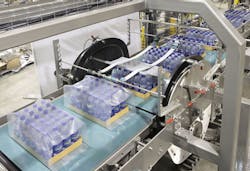Hartness International (www.hartness.com), a supplier of top-load case packers and a growing number of other packaging and material handling systems, makes a GlobalShrink TFS system that collates and wraps containers in shrink film for transfer to a shrink tunnel. On a machine operating at speeds to 100/min, a network of sensors that identify and verify accurate positioning of containers and wrapping materials is crucial. Hartness accomplishes the verification it needs by incorporating nearly 20 Sick (www.sickusa.com) photocells in its GlobalShrink system.
“Sick is especially strong when it comes to film registration detection,” says Mathias Coulomb, Hartness GlobalShrink product manager. “When the film being applied has graphics, it needs to be oriented properly or the graphics won’t look good on the store shelf. Contrast sensors are used to perform this important task of print registration.”
Often enough, the film being applied is perfectly clear. According to Coulomb, detecting a transparent object is no easy task. Once again, it’s a task that the Sick sensors are especially good at it, says Coulomb. According to Sick, it developed technology called OES3 to overcome this type of challenge and make these sensors capable of more intelligent signal analysis. An application-specific integrated circuit (ASIC) designed specifically for sensing transparent objects plays a key role in delivering this functionality, says Sick’s Packaging Market Manager Brian Whitt.
A third variety of Sick photocell used by Hartness, a variety pretty commonly used wherever photocells are involved, is the retro-reflective sensor, which uses a reflector to bounce a signal back to the sensor. It’s retro-reflective sensors that Hartness uses for detecting presence or absence of containers and paperboard trays.
The fourth and final variety of Sick sensor on the Hartness machine is an ultrasonic sensor. According to Coulomb, these help keep film tension smooth and consistent by measuring the diameter of the film on its roll.
Inputs from all of the photocells on the Global Shrink unit are conveyed to a Rockwell (www.rockwellautomation.com) ControlLogix PLC by way of an ASi network. If the input from the sensors indicates that the shrink film or a corrugated pad or the collated bottles are not where they are supposed to be, the PLC sounds an alarm so that corrective action can be taken.
Hartness International
www.hartness.com
Sick
www.sickusa.com
Rockwell
www.rockwellautomation.com
Subscribe to Automation World's RSS Feeds for Feature Articles
About the Author
Pat Reynolds
VP Editor Emeritus

Leaders relevant to this article:
